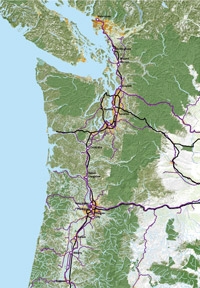PSU Students Complete Cascadia High Speed Rail Report

Portland State University students working with students at the University of Washington have completed a fifth volume report on the possibilities of High Speed Rail in the Northwest.
Working with Ethan Seltzer of Portland State and Daniel Carlson of the University of Washington, the students have spent the past months traveling between Seattle and Portland, attending workshops, and researching the impacts and benefits of High Speed Rail development. OTREC helped the students and professors put together several charettes in Portland and Seattle, and also provided funds for student travel between cities, according to John MacArthur, OTREC Sustainable Transportation Program Manager.
The resulting report, Ecolopolis 5.0: High Speed Rail in Cascadia (Read The Full Report Here), gives an in-depth look at how investment in High Speed Rail could tie together the region from Eugene all the way to Vancouver B.C. Carlson, senior lecturer of public affairs in the Evans School of Public Affairs at UW, said the report goes into more detail than most government research into High Speed Rail ever has before.
“We looked at the impacts (of High Speed Rail) in a broader range than most Departments of Transportation would look at,” Carlson said. “We wanted to understand the impact of development around stations, commerce exchange, and the environmental impact both immediately and in a broader regional corridor.”
While the term High Speed Rail is used in the document, the students found the potential for “Higher Speed Rail” was more of an economic reality in the Northwest with current freight alignments, Seltzer said. It’s not that it can’t be done, but students found many in planning had low expectations for High Speed Rail’s potential economic benefits. Changing those ideas, Seltzer said, will be a key part of further rail development. Seltzer is an urban studies and planning professor examining the history and practice of regional growth planning at PSU.
“Right now, the region is looking at trains that go 79 miles per hour rather than the High Speed Rail used globally,” Seltzer said. “Cascadia is a territory that has never been linked in this manner. Seattle isn’t part of Portland’s reality. To achieve real High Speed Rail, we must require investment and explore new forms of government and operational agreements.”
The students seemed to have similar hesitance when it came to investment in High Speed Rail, Carlson said. While some were adamant that High Speed Rail like that used in Europe was key to connecting the region, most others favored the Higher Speed Rail option because infrastructure investments would be more manageable for state DOTs.
“In the sixties or seventies, there was a greater sense of confidence in technology, especially when we sent a person to the moon,” Carlson said. “In this recession, there has been a sense of narrowing expectations. The students were being very realistic, examining ways to make modest changes to rail alignments that didn’t cost a lot.”
More planning and research must be done before DOTs in Oregon, Washington and someday, Canada, can start to think seriously about High Speed Rail Development, Seltzer said. An Environmental Impact Statement is planned to examine impacts of rail between Portland and Eugene. In the meantime, Carlson would like to see UW and PSU work on more educational collaborations in the future.
“It was challenging, it was more work, but we developed richer programmatic options for study than before,” Carlson said. “The quality of work was quite high and there have been many rewards.”
